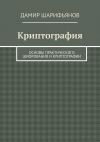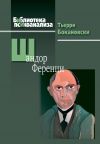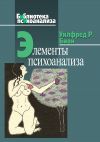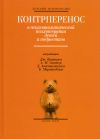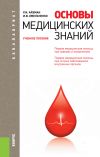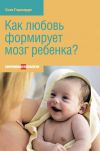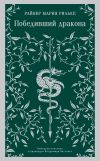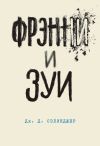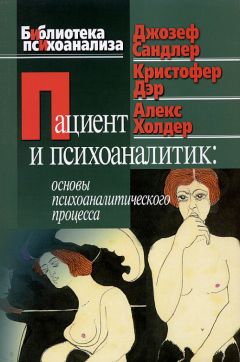
Автор книги: Джозеф Сандлер
Жанр: Зарубежная психология, Зарубежная литература
Возрастные ограничения: +16
сообщить о неприемлемом содержимом
Текущая страница: 16 (всего у книги 17 страниц)
FERENCZI, S., RANK, O. (1925). The Development of Psycho-Analysis. – N.Y.; Washington: Nervous & Mental Diseases Publishing Company.
FISCHER, N. (1971). An interracial analysis: transference and counter-transference significance // Journal of the American Psychoanalytic Association, 19, 736–745.
FLIESS, R. (1942). The metapsychology of the analyst // Psychoanalytic Quarterly, 11, 211–227.
FLIESS, R. (1953). Counter-transference and counter-identification // Journal of the American Psychoanalytic Association, 1, 268–284.
FONAGY, P. (1990). Discussion of Kit Bollas’s paper, «The origins of the therapeutic alliance» // Paper to Weekend Conference for English-speaking Members of European Societies. – Lndn.
FRANK, A. (1985). Id resistance and the strengh of the instincts // H.P. BLUM (Ed.), Defense and Resistance. – N.Y.: International Universities Press.
FRENCH, T.M. (1939). Insight and distortion in dreams // International Journal of Psycho-Analysis, 20: 287–298.
FREUD, A. (1928). Introduction to the Technique of Child Analysis. – N.Y.; Washington: Nervous & Mental Diseases Publishing Company. Рус. пер.: Фрейд А. Введение в технику детского психоанализа. М., 1991.
FREUD, А. (1936). The Ego and the Mechanisms of Defense. – Lndn.: Hogarth Press. Рус. пер.: Фрейд А. Психология Я и защитные механизмы. М.: Педагогика – Пресс, 1993.
FREUD, A. (1954). The widening scope of indications for psychoanalysis: discussion // Journal of the American Psychoanalytic Association, 2, 607–620.
FREUD, A. (1965). Normality and Pathology in Childhood. – Lndn.: Hogarth Press, 1926. [Reprinted Lndn: Karnac Books, 1989.]
FREUD, A. (1968). Acting out // International Journal of Psycho-Analysis, 49: 165–170.
FREUD, A. (1969). Difficulties in the Path of Psychoanalysis – N.Y.: International Universities Press.
FREUD, A. (1971). The infantile neurosis // The Psychoanalytic Study of the Child, 26: 79–90.
FREUD, A. (1981). Insight, its presence and absence as a factor in normal development // The Psychoanalytic Study of the Child, 36: 241–249.
FREUD, S. (1895d). Studies on Hysteria // Standard Edition, 2. – Lndn.: Hogarth Press.
FREUD, S. (1896b). Further remarks on the neuro-psychoses of defence // Standard Edition, 3. – Lndn.: Hogarth Press.
FREUD, S. (1897). Letter to Wilhelm Fliess of 21 September 1897 // The Origins of Psycho-Analysis: Letters to Wilhelm Fliess, Drafts and Notes. – Lndn.: Imago, 1954.
FREUD, S. (1900a). The Interpretation of Dreams. // Standard Edition, 4–5. – Lndn.: Hogarth Press. Рус. пер.: Фрейд 3. Толкование сновидений. М.: Современные проблемы, 1913.
FREUD, S. (1901b). The Psychopathology of Everyday Life. // Standard Edition, 6. – Lndn.: Hogarth Press. Рус. пер.: Фрейд 3. Психопатология обыденной жизни. М.: Современные проблемы, 1926.
FREUD, S. (1904a). Freud’s psycho-analytic procedure. // Standard Edition, 7. – Lndn.: Hogarth Press.
FREUD, S. (1905d). Three essays on the theory of sexuality // Standard Edition, 7. – Lndn.: Hogarth Press. Рус. пер.: Фрейд 3. Очерки по психологии сексуальности. М.: МЦ «Система», 1989.
FREUD, S. (1905е) [1901]). Fragment of an analysis of a case of hysteria. // Standard Edition, 7. – Lndn.: Hogarth Press.
FREUD, S. (1910a) [1909]). Five lectures on psycho-analysis. // Standard Edition, 11. – Lndn.: Hogarth Press. Рус. пер.: О психоанализе // Фрейд 3. Психология бессознательного. М.: Просвещение, 1989. – С. 346–381.
FREUD, S. (1909b). Analysis of a phobia in a five-year-old boy. // Standard Edition, 10. – Lndn.: Hogarth Press. Рус. пер.: Анализ фобии пятилетнего мальчика // Фрейд 3. Психология бессознательного. М.: Просвещение, 1989. – С. 39—122.
FREUD, S. (1909d). Notes upon a case of obsessional neurosis. // Standard Edition, 10. – Lndn.: Hogarth Press.
FREUD, S. (1910d). The future prospects of psycho-analytic therapy. // Standard Edition, 11. – Lndn.: Hogarth Press.
FREUD, S. (1911c). Psycho-analytic notes on an autobiographical account of a case of paranoia (Dementia Paranoides). // Standard Edition, 12. – Lndn.: Hogarth Press.
FREUD, S. (1911e). The handling of dream-interpretation in psycho-analysis. // Standard Edition, 12. – Lndn.: Hogarth Press.
FREUD, S. (1912b). The dynamics of transference. – Standard Edition, 12. // Lndn.: Hogarth Press.
FREUD, S. (1912e). Recommendations to physicians practising psychoanalysis. // Standard Edition, 12. – Lndn.: Hogarth Press.
FREUD, S. (1913c). On beginning the treatment (Further recommendations on the technique of psycho-analysis, I). // Standard Edition, 12. – Lndn.: Hogarth Press.
FREUD, S. (1913i). The disposition to obsessional neurosis. // Standard Edition, 12. – Lndn.: Hogarth Press.
FREUD, S. (1914c). On narcissism: an introduction. // Standard Edition, 14. – Lndn.: Hogarth Press.
FREUD, S. (1914g). Remembering, repeating and working-through (Further recommendations on the technique of psycho-analysis, II). // Standard Edition, 12. – Lndn.: Hogarth Press.
FREUD, S. (1915a). Observations on transference-love (Further recommendations on the technique of psycho-analysis, III). // Standard Edition, 12. – Lndn.: Hogarth Press.
FREUD, S. (1915с). Instincts and their vicissitudes. // Standard Edition, 14. – Lndn.: Hogarth Press. Рус. пер.: Влечения и их судьба // Фрейд 3. Основные психологические теории в психоанализе. М.; Пг.: ГИЗ, 1923. – С. 103–124.
FREUD, S. (1915f). A case of paranoia running counter to the psychoanalytic theory of the disease. // Standard Edition, 14. – Lndn.: Hogarth Press.
FREUD, S. (1916d). Some character-types met with in psycho-analytic work. // Standard Edition, 14. – Lndn.: Hogarth Press.
FREUD, S. (1916–1917). Introductory Lectures on Psycho-Analysis. // Standard Edition, 15–16. – Lndn.: Hogarth Press. Рус. пер.: Фрейд 3. Введение в психоанализ. Лекции. М.: Наука, 1989.
FREUD, S. (1918b [1914]). From the history of an infantile neurosis. // Standard Edition, 17. – Lndn.: Hogarth Press.
FREUD, S. (1920g). Beyond the Pleasure Principle. – Standard Edition, 18. // Lndn.: Hogarth Press. Рус. пер.: По ту сторону принципа удовольствия // Фрейд 3. Психология бессознательного. М.: Просвещение, 1989. – С. 382–424.
FREUD, S. (1921с). Group Psychology and the Analysis of the Ego. // Standard Edition, 18. – Lndn.: Hogarth Press. Рус. пер.: Массовая психология и анализ человеческого «Я» // Фрейд 3. По ту сторону принципа удовольствия. М.: Прогресс, 1992. – С. 256–324.
FREUD, S. (1923b). The Ego and the Id. // Standard Edition, 19. – Lndn.: Hogarth Press. Рус. пер.: Я и Оно // Фрейд 3. Психология бессознательного. М.: Просвещение, 1989. – С. 425–439.
FREUD, S. (1924с). The economic problem of masochism. // Standard Edition, 19. – Lndn.: Hogarth Press.
FREUD, S. (1925d). An Autobiographical Study. // Standard Edition, 20. – Lndn.: Hogarth Press.
FREUD, S. (1926d) Inhibitions, Symptoms and Anxiety. // Standard Edition, 20. – Lndn.: Hogarth Press.
FREUD, S. (1926e). The Question of Lay Analysis. // Standard Edition, 20. – Lndn.: Hogarth Press.
FREUD, S. (1931b). Female sexuality. // Standard Edition, 21. – Lndn.: Hogarth Press.
FREUD, S. (1933a). New Introductory Lectures on Psycho-Analysis. // Standard Edition, 22. – Lndn.: Hogarth Press. Рус. пер.: Фрейд 3. Введение в психоанализ. Лекции. М.: Наука, 1989.
FREUD, S. (1937с). Analysis terminable and interminable. // Standard Edition, 23. – Lndn.: Hogarth Press.
FREUD, S. (1937d). Construction in analysis. // Standard Edition, 23. – Lndn.: Hogarth Press.
FREUD, S. (1939a). Moses and Monotheism. // Standard Edition, 23. – Lndn.: Hogarth Press. Рус. пер.: Человек Моисей и монотеистическая религия // Фрейд 3. Психоанализ. Религия. Культура. М.: Ренессанс, 1992. – С. 135–256.
FREUD, S. (1940а [1938]). An Outline of Psycho-Analysis. // Standard Edition, 23. – Lndn.: Hogarth Press.
FREUD, S. (1950a [1887–1902]). The Origins of Psycho-Analysis. // Standard Edition, 1. – Lndn.: Hogarth Press.
FRIEDMAN, L. (1969). The therapeutic alliance // International Journal of Psycho-Analysis, 50: 139–153.
FROMM-REICHMANN, F. (1950). Principles of Intensive Psychotherapy. – Chicago: Chicago University Press.
FROSCH, J. (1967). Severe regressive states during analysis // Journal of the American Psychoanalytic Association, 15, 491–507; 606–625.
FROSCH, J. (1983). The Psychotic Process. – N.Y.: International Universities Press.
GABBARD, G.O., HORWITZ, L., FRIESWYK, S., ALLEN, J.G., COLSON, D.B., NEWAOM, G., COYNE, L. (1988). The effect of therapist interventions on the therapeutic alliance with borderline patients // Journal of the American Psychoanalytic Association, 36, 657–727.
GEDO, J.E. (1979). Beyond Interpretation. – N.Y.: International Universities Press.
GERO, G. (1936). The construction of depression // International Journal of Psycho-Analysis, 17: 423–461.
GERO, G. (1951). The concept of defense // Psychoanalytic Quarterly, 17, 565–578.
GERSTLEY, L., McLELLAN, A.T., ALTERMAN, A.I., WOODY, G.E., LUBORSKY, L., PROUT, M. (1989). Ability to form an alliance with the therapist: a possible marker of prognosis for patients with antisocial personality disorder // American Journal of Psychiatry, 146: 508–512.
GILL, H.S. (1988). Working through resistances of intrapsychic and environmental origins // International Journal of Psycho-Analysis, 69: 535–550.
GILL, M.M. (1954). Psychoanalysis and exploratory psychotherapy // Journal of the American Psychoanalytic Association, 2, 771–797.
GILL, M.M. (1982). Analysis of Transference: Vol. 1. Theory and Technique. – N.Y.: International Universities Press.
GILLMAN, R.D. (1987). A child analyzes a dream // The Psychoanalytic Study of the Child, 42: 263–273.
GIOVACCHINI, P. (1987a). Treatment, holding environment and transitional space // Modem Psychoanalysis, 12: 151–162.
GITELSON, M. (1952). The emotional position of the analyst in the psychoanalytic situation // International Journal of Psycho-Analysis, 33: 1—10.
GITELSON, M. (1954). Therapeutic problems in the analysis of the «normal» candidate // International Journal of Psycho-Analysis, 35: 174–183.
GITELSON, M. (1962). The curative factors in psychoanalysis // International Journal of Psycho-Analysis, 43: 194–205.
GLOVER, E. (1931). The therapeutic effect of inexact interpretation // International Journal of Psycho-Analysis, 12: 397–411.
GLOVER, E. (1937). The theory of the therapeutic results of psychoanalysis // International Journal of Psycho-Analysis, 18: 125.
GLOVER, E. (1955). The Technique of Psycho-Analysis. – Lndn.: Bailliere, Tindall & Cox.
GRAY, P. (1990). The nature of therapeutic action in psychoanalysis // Journal of the American Psychoanalytic Association, 38, 1083–1097.
GREENACRE, P. (1950). General problems of acting out // Psychoanalytic Quarterly, 19, 455–467.
GREENACRE, P. (1956). Re-evaluation of the process of working through // International Journal of Psycho-Analysis, 37: 439–444.
GREENACRE, P. (1968). The Psychoanalytic process, transference and acting out // Emotional Growth. – N.Y.: International Universities Press, 1971.
GREENBAUM, H. (1956). Combined psychoanalytic therapy with negative therapeutic reactions // A.H. Rifkin (Ed.), Schizophrenia in Psychoanalytic Office Practice. – N.Y.: Grune & Stratton.
GREENSON, R.R. (1965a). The working alliance and the transference neurosis // Psychoanalytic Quarterly, 34, 155–181.
GREENSON, R.R. (1965b). The problem of working through // M. Schur (Ed.), Drives, Affects, Behavior. – N.Y: International Universities Press.
GREENSON, R.R. (1966). Comment on Dr. Limentani’s paper // International Journal of Psycho-Analysis, 47: 282–285.
GREENSON, R.R. (1967). The Technique and Practice of Psychoanalysis, Vol. 1. – N.Y.: International Universities Press. Рус. пер.: Гринсон P.P. Техника и практика психоанализа. Воронеж: НПО «Модэк», 1994.
GREENSON, R.R., WEXLER, М. (1969). The non-transference relationship in the psychoanalytic situation // International Journal of Psycho-Analysis, 50: 27–39.
GRINBERG, L. (1962). On a specific aspect of counterntransference due to the patient’s projective identification // International Journal of Psycho-Analysis, 43: 436–440.
GRINBERG, L. (1968). On acting out and its role in the psychoanalytic process // International Journal of Psycho-Analysis, 49: 171–178.
GRINBERG, L. (1987). Dreams and acting out // Psychoanalytic Quarterly, 56, 155–176.
GRUNERT, U. (1979). Die negative therapeutische Reaktion als Ausdruck einer Stoerung im Losloesungs – und Individuationsprozess // Psyche, 33, 1—29.
GUNDERSON, J.G. (1977). Characteristics of bordelines // P. Hartocollis (Ed.), Borderline Personality Disorders: The Concept, the Symptom, the Patient. – N.Y.: International Universities Press.
GUNDERSON, J.G. (1984). Borderline Personality Disorder. – Washington, DC: American Psychatric Press.
GUTHEIL, Т.G., HAVENS, L.L. (1979). The therapeutic alliance: contemporary meanings and confusions // International Review of Psychoanalysis, 6: 467–481.
HALPERT, E. (reporter) (1984). Panel: The value of extratransference interpretation // Journal of the American Psychoanalytic Association, 32, 137–146.
HAMMETT, V.B.O. (1961). Delusional transference // American Journal of Psychotherapy, 15: 574–581.
HANLY, C. (1981). Narcissism, defence and the positive transference // International Journal of Psycho-Analysis, 63: 427–444.
HARLEY, M. (1971). The current status of transference neurosis in children // Journal of the American Psychoanalytic Association, 19, 26–40.
HARTMANN, H. (1939). Ego Psychology and the Problem of Adaptation. – Lndn.: Imago, 1958.
HARTMANN, H. (1944). Psychoanalysis and sociology // Essays on Ego and Psychology. – Lndn.: Hogarth Press, 1964.
HARTMANN, H. (1951). Technical implications of ego psychology // Psychoanalytic Quarterly, 20, 31–43.
HARTMANN, H. (1956). The development of the ego concept in Freud’s work // International Journal of Psycho-Analysis, 37: 425–438.
HARTMANN, H. (1964). Essays on Ego Psychology. – Lndn.: Hogarth Press.
HATCHER, R.L. (1973). Insight and self-observation // Journal of the American Psychoanalytic Association, 21, 377–398.
HEIMANN, P. (1950). On counter-transference // International Journal of Psycho-Analysis, 31: 81–84.
HEIMANN, P. (1960). Counter-transference // British Journal of Medical Psychology, 33: 9—15.
HILL, D. (1968). Depression: disease, reaction or posture? // American Journal of Psychiatry, 125: 445–457.
HINSHELWOOD, R.D. (1989). A Dictionary of Kleinian Thought. – Lndn: Free Association Books.
HINSIE, L.E., CAMPBELL, R.J. (1970). Psychiatric Dictionary (4th edition). – Lndn: Oxford University Press.
HOFFER, W. (1956). Transference and transference neurosis // International Journal of Psycho-Analysis, 37: 377–379.
HOLDER, A. (1970). Conceptual problems of acting out in children // Journal of Child Psychotherapy, 2: 5—22.
HOKNEY, К. (1936). The problem of the negative therapeutic reaction / / Psychoanalytic Quarterly, 5, 29–44.
HOROWITZ, M.H. (1987). Some notes on insight and its failures // Psychoanalytic Quarterly, 56, 177–198.
INFANTE, J.A. (1976). Acting out: a clinical reappraisal // Bulletin of the Menninger Clinic, 40: 315–324.
ISAAKS, S. (1939). Criteria for interpretation // International Journal of Psycho-Analysis, 20: 148–160.
IVIMEY, M. (1948). Negative therapeutic reaction // American Journal of Psychoanalysis, 8: 24–33.
JACOBS, T.J. (1973). Posture, gesture, and movement in the analysis: cues to interpretation and countertransference // Journal of the American Psychoanalytic Association, 21, 77–92.
JACOBS, T.J. (1983). The analyst and the patient’s object world: notes on an aspect of countertransference // Journal of the American Psychoanalytic Association, 31, 619–642.
JACOBS, T.J. (1986). On countertransference enactments // Journal of the American Psychoanalytic Association, 34, 289–307.
JACOBS, T.J. (1987). Notes on the unknowable: analytic secrets and the transference neurosis // Psychoanalytic Inquiry, 7, 485–509.
JASPERS, K. (1913). Allgemeine Psychopathologie. – Berlin: Springer Verlag.
JOFFE, W.G., SANDLER, J. (1965). Notes on pain, depression and individuation // Psychoanalytic Study of the Child, 20: 394–424.
JOFFE, W.G., SANDLER, J. (1967). On the concept of pain, with special reference to depression and psychogenic pain // Journal of Psychosomatic Research, 11: 69–75.
JONES, E. (1955). Sigmund Freud: Life and Work, Vol. 2. – N.Y.: Basic Books.
JOSEPH, B. (1985). Transference: the total situation // International Journal of Psycho-Analysis, 66: 447–454.
JOSEPH, B. (1987). Projective identification: clinical aspects // J. Sandier (Ed.), Projection, Identification, Projective Identification. – Madison CT: International Universities Press.
JUNG, C.G. (1907). Ueber die Psychologic der Dementia Praecox: Ein Versuch, Halle A.S. // Collected Works, Vol. 3. – Lndn: Routledge & Kegan Paul, 1960.
KANZER, M. (1981). Freud's «analytic pact»: the standard therapeutic alliance // Journal of the American Psychoanalytic Association, 29, 69–87.
KAPLAN, A. (1964). The Conduct of Inquiry. – San Francisco: Chandler Publishing Co.
KEMPER, W.W. (1966). Transference and countertransference as a functional unit: Official Report on Pan-American Congress for Psycho-Analysis.
KENNEDY, H. (1979). The role of insight in child analysis: a developmental viewpoint // Journal of the American Psychoanalytic Association, 27 (supplement), 9—28.
KEPECS, J.G. (1966). Theories of transference neurosis // Psychoanalytic Quarterly, 35, 497–521.
KERNBERG, O.F. (1965). Notes on countertransference // Journal of the American Psychoanalytic Association, 13, 38–56.
KERNBERG, O.F. (1967). Borderline personality organisation // Journal of the American Psychoanalytic Association, 15, 641–685.
KERNBERG, O.F. (1975). Borderline Conditions and Pathological Narcissism. – N.Y.: Jason Aronson.
KERNBERG, O.F. (1976a). Object Relations Theory and Clinical Psychoanalysis. – N.Y.: Jason Aronson.
KERNBERG, O.F. (1976b). Technical considerations in the treatment of borderline personality organisation // Journal of the American Psychoanalytic Association, 24, 795–829.
KERNBERG, O.F. (1980a). Character structure and analyzability // Bulletin of the Association of Psychoanalytic Medicine, 19: 87–96.
KERNBERG, O.F. (1980b). Internal World and External Reality. – N.Y.: Jason Aronson.
KERNBERG, O.F. (1985). Object relations theory and character analysis // H.P. Blum (Ed.), Defense and Resistance. – N.Y.: International Universities Press.
KERNBERG, O.F. (1987). An ego psychology-object relations theory approach to the transference // Psychoanalytic Quarterly, 56, 197–221.
KERNBERG, O.F. (1988). Object relations theory in clinical practice // Psychoanalytic Quarterly, 57, 481–504.
KERZ-RUEHLING, I. (1986). Freuds Theorie der Einsicht // Psyche, 40: 97—123.
KHAN, M.M.R. (1960). Regression and integration in the analytic setting // International Journal of Psycho-Analysis, 41: 130–146.
KHAN, M.M.R. (1963). Silence as communication // Bulletin of the Menninger Clinic, 27: 300–317.
KHAN, M.M.R. (1972). Dread of surrender to resourceless dependence in the analytic situation // International Journal of Psycho-Analysis, 53: 225–230.
KING, P. (1974). Notes on the psychoanalysis of older patients. Reappraisal of the potentialities for change during the second half of life // Journal of Analytical Psychology, 19: 22–37.
KLAUBER, J. (1972). On the relationship of transference and interpretation in psychoanalytic therapy // International Journal of Psycho-Analysis, 53: 385–391.
KLAUBER, J. (1980). Formulating interpretation in clinical psychoanalysis // International Journal of Psycho-Analysis, 61: 195–202.
KIAUBER, J. (1981). Difficulties in the Analytic Encounter. – N.Y.: Jason Aronson. [Reprinted Lndn: Karnac Books, 1986.]
KLEIN, M. (1932). The Psycho-Analysis of Children. – Lndn.: Hogarth Press.
KLEIN, M. (1946). Notes on some schizoid mechanism // M. Klein, P. Heiman, S. Isaacs, & J. Riviere (Eds.), Developments in Psycho-Analysis. – Lndn.: Hogarth Press, 1952. [Reprinted Lndn: Karnac Books, 1989.]
KLEIN, M. (1948). Contributions to Psycho-Analysis. – Lndn.: Hogarth Press.
KLEIN, M. (1957). Envy and gratitude // Envy and Gratitude and Other works, 1946–1963. – Lndn.: Hogarth Press, 1975.
KLUEWER, R. (1983). Agieren und Mitagieren // Psyche, 37: 828–840.
KNIGHT, R.P. (1940). Introjection, projection and identification // Psychoanalytic Quarterly, 9, 334–341.
KNIGHT, R.P. (1953). Borderline states // Bulletin of the Menninger Clinic, 17: 1—12.
KOEHLER, W. (1925). The Mentality of Apes. – N.Y.: Harcourt Brace & World Inc. Рус, пер.: Келер В. Исследование интеллекта человекоподобных обезьян. М.: Изд-во Комм. академии, 1930.
KOHUT, Н. (1966). Forms and transformations of narcissism // P. Ornstein (Ed.), The Search for the Self. – N.Y.: International Universities Press.
KOHUT, H. (1968). The psychoanalytic treatment of narcistic personality disorders. Outline of a systematic approach // The Psychoanalytic Study of the Child, 23: 86—113.
KOHUT, H. (1971). The Analysis of the Self. – N.Y.: International Universities Press.
KOHUT, H. (1977). The Restoration of the Self. – N.Y.: International Universities Press.
KOHUT, H. (1984). How Does Analysis Cure? – Chicago: University of Chicago Press.
KRAEPELIN, E. (1906). Lectures on Clinical Psychiatry – N.Y.: Hafner, 1969.
KRAMER, M.K. (1959). On the continuation of the analytic process after psychoanalysis // International Journal of Psycho-Analysis, 40: 17–25.
KRIS, E. (1951). Ego psychology and interpretation in psychoanalytic therapy // Psychoanalytic Quarterly, 20, 15–29.
KRIS, E. (1952). Explorations in Art. – N.Y.: International Universities Press.
KRIS, E. (1956a). The recovery of childhood memories in psychoanalysis // The Psychoanalytic Study of the Child, 11: 54–88.
KRIS, E. (1956b). On some vicissitudes of insight in psychoanalysis // International Journal of Psycho-Analysis, 37: 445–455.
KUBIE, L.S. (1950). Practical and Theoretical Aspects of Psychoanalysis – N.Y.: International Universities Press.
LAMPL-DE GROOT, J. (1967). On obstacles standing in the way of psycho-analytic cure // The Psychoanalytic Study of the Child, 22: 20–35.
LANGS, R.J. (1975). The therapeutic relationship and deviations in technique // International Journal of Psychoanalytic Psychotherapy, 4: 106–141.
LANGS, R J. (1976). The Therapeutic Interaction, Vols. 1 and 2. – N.Y.: Jason Aronson.
LANGS, R. J. (1978). The adaptational-interactional dimension of counter-transference // Contemporary Psychoanalysis, 14: 502–533.
LAPLANCHE, J., PONTALIS, J.B. (1973). The Language of Psychoanalysis. – Lndn.: Hogarth Press. [Reprinted Lndn: Karnac Books, 1988.]
LASKY, R. (1989). Some determinants of the male analyst's capacity to identify witn female patients // International Journal of Psycho-Analysis, 70: 405–418.
LEIDER, R.J. (reporter) (1984). Panel: The neutrality of the analyst in the analytic situation // Journal of the American Psychoanalytic Association, 32, 573–585.
LEITES, N. (1977). Transference interpretations only? // International Journal of Psycho-Analysis, 58: 275–287.
LESTER, E.P. (1985). The female analyst and the erotized transference // International Journal of Psycho-Analysis, 66: 283–293.
LEVY, J. (1982). A particular kind of negative therapeutic reaction based on Freud’s «borrowed guilt» // International Journal of Psycho-Analysis, 63: 361–368.
LEWIN, B. (1950). The Psychoanalysis of Elation – N.Y.: W.W. Norton.
LEWIN, B. (1961). Reflections on depression // Psychoanalytic Study of the Child, 16: 321–331.
LIDZ, Т., FLECK, S., CORNELISON, A. (Eds.) (1965) Schizophrenia and the Family. – N.Y.: International Universities Press.
LIMENTANI, A. (1966). A re-evaluation of acting out in relation to working through // International Journal of Psycho-Analysis, 47: 274–282.
LIMENTANI, A. (1981). On some positive aspects of the negative therapeutic reaction // International Journal of Psycho-Analysis, 62: 379–390.
LIPTON, S.D. (1977). Clinical observations on resistance to the transference // International Journal of Psycho-Analysis, 58: 463–472.
LITTLE, M. (1951). Countertransference and the patients respose to it // International Journal of Psycho-Analysis, 32: 32–40.
LITTLE, M. (1958). On delusional transference (transference psychosis) // International Journal of Psycho-Analysis, 39: 134–138.
LITTLE, M. (1960a). On basic unity // International Journal of Psycho-Analysis, 41: 377–384.
LITTLE, M. (1960b). Countertransference // British Journal of Medical Psychology, 33: 39–31.
LITTLE, M. (1966) Transference in borderline states // International Journal of Psycho-Analysis, 47: 476–485.
LOEWALD, H.W. (1960). On the therapeutic action of psychoanalysis // International Journal of Psycho-Analysis, 41: 16–33.
LOEWALD, H.W. (1972). Freud’s conception of the negative therapeutic reaction with comments on instinct theory // Journal of the American Psychoanalytic Association, 20, 235–245.
LOEWALD, H.W. (1974). Current status of the concept of infantile neurosis: discussion // The Psychoanalytic Study of the Child, 29: 183–190.
LOEWALD, H.W. (1979). Reflections of the psychoanalytic process and its therapeutic potential // The Psychoanalytic Study of the Child, 34: 155–168.
LOEWALD, H.W. (1986). Transference-countertransference // Journal of the American Psychoanalytic Association, 34, 275–287.
LOEWENSTEIN, R.M. (1951). The problem of interpretation // Psychoanalytic Quarterly, 20, 1—14.
LOEWENSTEIN, R.M. (1954). Some remarks on defences, autonomous ego and psychoanalytic technique // International Journal of Psycho-Analysis, 35: 188–193.
LOEWENSTEIN, R.M. (1969). Developments in the theory of transference in the last fifty years // International Journal of Psycho-Analysis, 50: 583–588.
LONDON, N.J. (1987). Discussion: in defense of the transference neurosis concept: a process and interactional definition // Psychoanalytic Inquiry, 7, 587–598.
LORAND, S. (1958). Resistance // Psychoanalytic Quarterly, 27, 462–464.
MAHLER, M.S. (1968). On Human Symbiosis and the Vicissitudes of Individuation, Vol. 1. – N.Y.: International Universities Press.
MAHLER, M.S.. PINE, F., BERGMAN, A. (1975). The Psychological Birth of the Human Infant: Symbiosis and Individuation. – N.Y.: Basic Books. [Reprinted Lndn: Karnac Books, 1986.]
MAIN, T.F. (1957). The ailment // British Journal of Medical Psychology, 30: 129–145.
MAIN, T.F. (1989). The Ailment and Other Psychoanalytic Essays. – Lndn.: Free Association Books.
MANGHAM, C.A. (1981). Insight: pleasurable affects associated with insight and their origins in infancy // The Psychoanalytic Study of the Child, 36: 271–277.
MARTIN, A.R. (1952). The dynamics of insight // American Journal of Psychoanalysis, 12: 24–38.
MASTERSON, J. (1972). Treatment of the Borderline Adolescent. A Developmental Approach. – N.Y.: Wiley-Interscience.
MASTERSON, J. (1976). Psychotherapy of the Borderline Adult. A Developmental Approach. – N.Y.: Brunner/Mazel.
MASTERSON, J. (1978). New Perspectives on Psychotherapy of the Borderline Adult. – N.Y.: Brunner/Mazel.
McDOUGALL, J. (1978). Primitive communication and the use of countertransference // Contemporary Psychoanalysis, 14: 173–209.
McLAUGHLIN, J.T. (1981). Transference, psychic reality and countertransference // Psychoanalytic Quarterly, 50, 639–664.
McLAUGHLIN, J.T. (1983). Some observations on the application of frame theory to the psychoanalytic situation and process // Psychoanalytic Quarterly, 52, 167–179.
MEISSNER, W.W. (1978). Theoretical assumptions of concepts of the borderline personality // Journal of the American Psychoanalytic Association, 26, 559–598.
MELTZER, D. (1967). The Psychoanalytical Process. – Lndn: Heinemann.
MENNINGER, R. (1958). Theory of Psychoanalytic Technique. – N.Y.: Basic Books.
MICHELS, R. (1986). Oedipus and insight // Psychoanalytic Quarterly, 55, 599–617.
MISHLER, E.G., WAXLER, N.E. (1966). Family interaction patterns and schizophrenia: a review of current theories // International Journal of Psychiatry, 2: 375–413.
MITSCHERLICH-NIELSEN, M. (1968). Contribution to symposium on acting out // International Journal of Psycho-Analysis, 49: 188–192.
MODELL, A.H. (1984). Psychoanalysis in a New Context. – N.Y.: International Universities Press.
MODELL, A.H. (1988). The centrality of the psychoanalytic setting and the changing aims of treatment // Psychoanalytic Quarterly, 57, 577–596.
MODELL, A.H. (1989). The psychoanalytic setting as a container of multiple levels of reality: a perspective of the theory of psychoanalytic treatment // Psychoanalytic Inquiry, 9, 67–87.
MOELLER, M.L. (1977a). Zur Theorie der Gegenuebertragung // Psyche, 31: 142–166.
MOELLER, M.L. (1977b). Self and object in countertransference // International Journal of Psycho-Analysis, 58: 365–374.
MONEY-KYRLE, RE. (1956). Normal counter-transference and some of its deviations // International Journal of Psycho-Analysis, 37: 360–366.
MOORE, B.E., FINE, B.D. (1967). A Glossary of Psychoanalytic Terms and Concepts. – N.Y.: American Psychoanalytic Association.
MOORE, B.E., FINE, B.D. (1990). Psychoanalytic Terms and Concepts. – New Haven, CT: The American Psychoanalytic Association and Yale University Press.
MORGENTHALER, F. (1978). Technik. Zur Dialektik der psychoanalytischer Praxis. – Frankfurt: Syndicat.
MUSLIN, H. (1986). On working through in self psychology // A. Goldberg (Ed.), Progress in Self Psychology, Vol.2. – N.Y.: International Universities Press.
MYERSON, P.A. (1960). Awareness and stress: post-psychoanalytic utilization of insight // International Journal of Psycho-Analysis, 41: 147–156.
MYERSON, P.A. (1963). Assimilation of unconscious material // International Journal of Psycho-Analysis, 44: 317–327.
MYERSON, P.A. (1965). Modes of insight // Journal of the American Psychoanalytic Association, 13, 771–792.
NAIMAN, J. (reporter) (1976). Panel: The fundamental of psychic changes in clinical practice // International Journal of Psycho-Analysis, 57: 411–418.
NEUBAUER, P.B. (1979). The role of insight in psychoanalysis // Journal of the American Psychoanalytic Association, 27 (supplement), 29–40.
Правообладателям!
Это произведение, предположительно, находится в статусе 'public domain'. Если это не так и размещение материала нарушает чьи-либо права, то сообщите нам об этом.